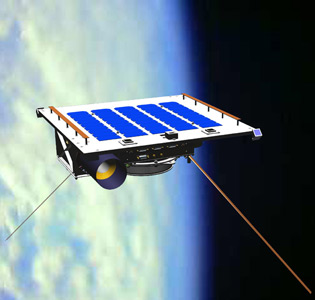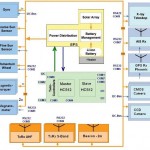The Max Valier satellite is a 15 kg amateur radio microsat planned for launch into a 700 km Sun Synchronous Orbit from Plesetsk.
The first mission is educational and involves two Technical High Schools (TFO) in South Tyrol, Italy. Its aim is to demonstrate the possibility to realize a micro satellite by a team of students and teachers of a High School.
Max Valier satellite in space
 The tasks of the two High Schools are:
The tasks of the two High Schools are:
1. Setup of two Ground Stations for communication with the satellite
2. Implementing a simple attitude control strategy which can be understood by High School Students
3. Realizing an Electronic Power Supply (EPS) for the Satellite
4. Manufacturing the mechanical structures of the satellite
5. Carrying out simple student experiments, such as a small CMOS camera
6. Measuring and Simulating radiation patterns of the employed antennas both in the satellite and in the ground stations
7. To carry out some communication experiments.
They are planning to use the following transceivers:
– A low power VHF Beacon built by DF2FQ that emits the identification of the spacecraft in CW at 60 characters per minute.
– An AstroDev HELIUM (UV/VU at 9600 bd) ISIS TRXUV (U/V at 1200/9600 bd
– A Schulze SRS TCM2 at 1200 bd
– A Schulze SRS TCM3 at 9600 bps
 The two Technical High Schools have no commercial aims.
The two Technical High Schools have no commercial aims.
Max Valier block diagram – Image credit Max Valier Gewerbeoberschule
The second mission belongs to the Amateur Astronomers, an association without commercial aims.
The spacecraft carries an X-Ray telescope built by the Max Planck Institute for Extraterrestrial Physics (Garching, Germany). Its data are to be evaluated by the Amateur Astronomers and to be made available to the public on a website.
The goal is to complete an X-Ray map of the space. The third mission is an independent experimental mission carried out by OHB System AG (Bremen, Germany) with the following goals: 1. Receive and demodulate AIS (Automatic Identification System) signals sent by ships to an experimental AIS receiver on the spacecraft MaxValier and retransmit those data to the earth over an S-Band link 2. Testing the behavior of ORBCOMM and IRIDIUM modems in space.
Further information from http://sat.gobbz.net/indexe.php
Source: Amsat UK
